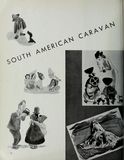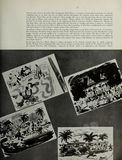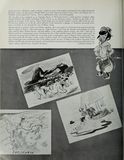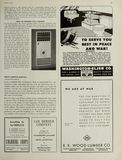



FOUR OF THE TWELVE OR MORE Silly Symphonies Walt Disney is creating on Latin-American themes are already completed and are on their way for an initial showing throughout the countries from which their inspiration was derived. These films are the result of a three months film survey trip through Latin America last summer on the part of Disney and a group of his co-workers. Disney admits he is biting his fingernails awaiting the reaction of his Latin American cousins to his impressions of their respective countries. Disney says. "During our trip down there, they let us know they appreciated the fact that we actually came down to them for our knowledge; that we made an honest effort to find out from them something of what they considered the most colorful and representative in their culture, customs, music, color, and humor.
According to Disney and his fellow artists, the trip also taught them a great deal of what not to do. For instance, they found that Brazilians believe that too many North Americans have the erroneous notion that Brazil is a big jungle, with Rio set in the middle of it – a carnival city with dancing in the streets 365 days of the year. In addition, relatively few people in the United States have ever heard of samha music. or know that it is indigenous to Brazil. The average North American takes it for granted that tangoes and rhumbas are played exclusively all
over South America.
In his Latin-American efforts, Disney is taking advantage of the musical research done by studio composer Charles Wolcott who accompanied him and, in every picture, is using music typical of the country involved. In his colorful Brazilian Silly Symphony. “Aquarela do Brasil," music, is as important as the characters. Samha music played by a Brazilian samba orchestra, consists of some of the numbers purchased by the studio during the Brazilian sojurn. In this picture, Donald Duck as a North American tourist co-stars with a new Disney star – a Brazilian parrot named Jose Carioca. Jose is sophisticated, witty, wise, and engaging.
The first film to be completed on an Argentina theme is “El Gaucho Goofy,” a light and airy "crackpot” affair wherein Disney’s old standby twitterpate, Goofy, is seen as an American cowboy whisked to the land of the gaucho by the magic of the camera. There, Goofy learns how his gaucho brother’s customs differ from his own. Several other subjects are in the fire which will give North Americans a glimpse of Argentine provincial color, types, and music as seen through the eyes of Disney artists.
Donald pops up in another of these new Disney vignettes. He is seen again as a North American tourist in the Lake Titicaca region of Bolivia. The inspiration for “Lake Titicaca” came from the sketches and paintings of artists Mary and Lee Blair, Herbert Ryman, and Jack Miller of the junketing Disney troupe, who took a side trip to Bolivia and Peru to photograph, paint, and sketch the life of that colorful region off the beaten tourist path. In Argentina. the group spent as little time as possible in the cosmopolitan center of Buenos Aires, preferring outlying regions where the true flavor of the country could be tasted. As a result, James Bodrero, Frank Thomas, and Larry Lansburgh spent considerable time in the Indian gaucho province of Salta in the northern Argentine, where Bodrero and Thomas painted and sketched, and Lansburgh learned gaucho customs and photographed typical costumes, customs, and the ways of gaucho horsemen.
In his completed Silly Symphonies, Chile is represented by a new character, a baby mail plane who has to fly the mail across the formidable Andes one day when his mother and father are “under the weather.” For this one, composer Wolcott wove the sprightly Chilean cueca-type tunes into a score tapestry, and the Disney artists set the whole background of action from sketches they made of the incredible snow-covered Andes.
Over the entire trip, Disney and his group admitted that they made a supreme effort of fleeing from their own countrymen, of listening to no one on the subject of what Argentines, Brazilians, Chileans, or Peruvians were like, and of letting their Latin-American neighbors do the talking. That Disney earned their sincere good favor by pursuing such a policy is summed up in the words of one Argentine gentleman who said with twinkling eyes: “We’ll even let you make a few mistakes with our gaucho, so long as you make us laugh.”